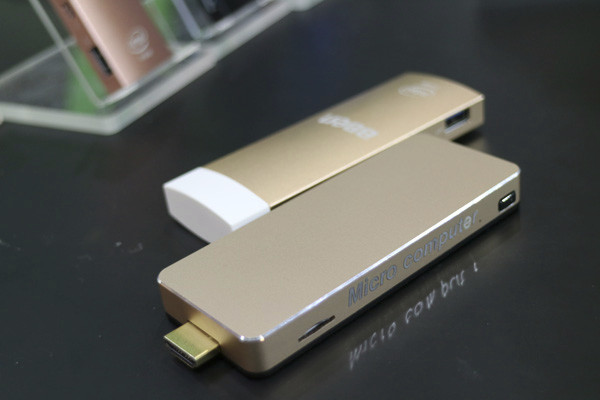Intel is planning to launch “Michigan City” Apollo Lake Compute Sticks sometimes with year, but Bben, after launching MN17A Apollo Lake mini PC, may be able to launch their own Celeron N3450 TV stick before Intel does, as Netbook Italia reports the company showcased such product at the Hong Kong Global Sources Electronics Fair.

Bben Micro computer specifications:
- SoC – Intel Celeron N3450 quad core processor @ 1.1 GHz / 2.2 GHz, 12 EU Intel HD graphics 500 @ 200 MHz / 700 MHz; 6W TDP
- System Memory – 2 to 4GB DDR3
- Storage – 32 or 64 GB eMMC flash + micro SD slot
- Video Output – HDMI port (likely limited to 1.4 version with 4K @ 30 Hz max resolution/framerate)
- Audio – HDMI + 3.5mm audio jack
- Connectivity – Dual band 802.11 b/g/n/ac WiFi, and Bluetooth 4.2
- USB – 2x USB 3.0 ports
- Misc – Fan and ventilation holes
- Power Supply – TBD via power barrel
- Dimensions & Weight – TBD (Metal housing)
The stick, whose name is still to be decided, will run Windows 10 or Android (version TBD), including a dual boot version. The first part of the video below introduced the Cherry Trail TV sticks, before a short description of the Apollo Lake one, and other products.

The new TV stick should be released this summer for a yet-to-be-determined price. You’ll likely be able to purchase it from Bben Official Aliexpress store once it comes out.

Jean-Luc started CNX Software in 2010 as a part-time endeavor, before quitting his job as a software engineering manager, and starting to write daily news, and reviews full time later in 2011.
Support CNX Software! Donate via cryptocurrencies, become a Patron on Patreon, or purchase goods on Amazon or Aliexpress. We also use affiliate links in articles to earn commissions if you make a purchase after clicking on those links.





No info on the power supply, which begs the question:
What’s the actual power of these intel solutions? (measured at the wall socket)
@Shimon
Some info taken from http://www.cnx-software.com/2017/01/30/voyo-v1-vmac-mini-apollo-lake-mini-pc-review-part-2-windows-10/#stress-test-fan-noise-and-power-consumption
Ok, so using your power usage numbers, it seems for twice the power used you get 2x more generic code performance (or even more if the code targets x86 SIMD)
https://openbenchmarking.org/result/1703204-RI-1703207KH46
If those intel devices cost roughly 2x more and were not burdened with a windows licence, that could make ARM solutions much less attractive.
And, the recently released ARM Compute Library should help close the SIMD gap.
MeegoPad T11 appears to be the same device -> https://androidpc.es/blog/2017/05/30/meegopad-t11-un-nuevo-mini-pc-en-formato-stick-con-intel-apollo-lake/